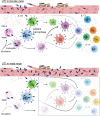The impact of biological sex on diseases of the urinary tract
- PMID: 35869147
- PMCID: PMC9305688
- DOI: 10.1038/s41385-022-00549-0
The impact of biological sex on diseases of the urinary tract
Abstract
Biological sex, being female or male, broadly influences diverse immune phenotypes, including immune responses to diseases at mucosal surfaces. Sex hormones, sex chromosomes, sexual dimorphism, and gender differences all contribute to how an organism will respond to diseases of the urinary tract, such as bladder infection or cancer. Although the incidence of urinary tract infection is strongly sex biased, rates of infection change over a lifetime in women and men, suggesting that accompanying changes in the levels of sex hormones may play a role in the response to infection. Bladder cancer is also sex biased in that 75% of newly diagnosed patients are men. Bladder cancer development is shaped by contributions from both sex hormones and sex chromosomes, demonstrating that the influence of sex on disease can be complex. With a better understanding of how sex influences disease and immunity, we can envision sex-specific therapies to better treat diseases of the urinary tract and potentially diseases of other mucosal tissues.
© 2022. The Author(s), under exclusive licence to Society for Mucosal Immunology.
Conflict of interest statement
D.A.H. serves on the Board of Directors of BioVersys AG, Basel, Switzerland and has received research funding from BioAge Labs, Richmond, CA, USA. All other authors have no conflicts to declare.
Figures



References
Publication types
MeSH terms
Substances
Grants and funding
LinkOut - more resources
Full Text Sources
Medical

